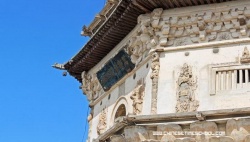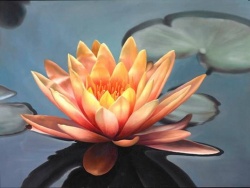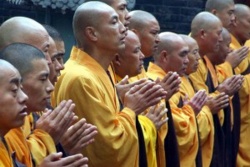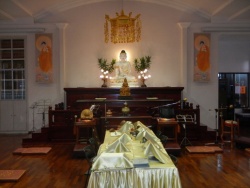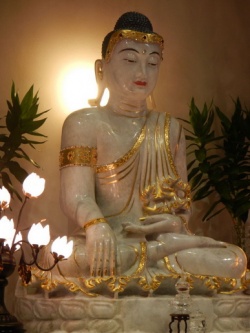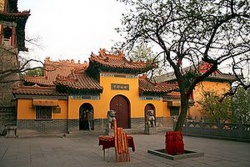Chinese Buddhism
Chinese Buddhism (simplified Chinese: 汉传佛教; traditional Chinese: 漢傳佛敎; pinyin: Hànchuán Fójiào) refers collectively to the various schools of Buddhism that have flourished in China since ancient times. Buddhism has played an enormous role in shaping the mindset of the Chinese people, affecting their aesthetics, politics, literature, philosophy and medicine.
At the peak of the Tang Dynasty's vitality, Chinese Buddhism produced numerous spiritual masters. Scholars classified Chinese buddhism into 7-15 schools, commonly into 10 schools, called the Ten Schools of the Han Transmission of Buddhism (汉传佛教十宗).
After the turmoil of the Cultural Revolution, Chinese Buddhism is growing again, with ancient monasteries being rebuilt and more people becoming taking ordination as monks and nuns.
Early history of Buddhism in China
Arrival of Buddhism from India
Earliest historical arrivals
Admitting the impossibility of saying "when or how the first Buddhist missions in China began", Kenneth Saunders mentions Ashoka and the Fayuan Zhulin (written 688 CE) noting missionaries arriving in Qin Dynasty (221–206 BCE) China. This Buddhist encyclopedia claims that in 217 BCE, the Monk Li Fang 李防 and seventeen others arrived in Xi'an – but this legend is uncorroborated by historical sources.
According to some European historians, Mauryan emperor Aśoka the Great sent the royal Monk Massim Sthavira to Nepal, Bhutan, and China to spread Buddhism around 265 BCE. However, it has not been widely confirmed that these missionaries arrived in China or that they were responsible for establishing the teachings of Buddhism there.
Generations of scholars have debated whether Buddhist missionaries first reached Han China via the maritime or overland [[Routes of The Silk Road]]. The maritime route hypothesis, favored by Liang Qichao and Paul Pelliot, proposed that Buddhism was originally practiced in southern China, the Yangtze River and Huai River region, where prince Ying of Chu (present day Jiangsu) was jointly worshipping the
Yellow Emperor, Laozi, and Buddha in 65 CE. The overland route hypothesis, favored by Tang Yongtong, proposed that Buddhism disseminated eastward through Yuezhi and was originally practiced in western China, at the Han capital Luoyang (present day Henan),
where Emperor Ming of Han established the White Horse Temple in 68 CE. Rong Xinjiang, a history professor at Peking University, reexamined the overland and maritime hypotheses through a multi-disciplinary review of recent discoveries and research, including the Gandhāran Buddhist Texts, and concluded.
- The view that Buddhism was transmitted to China by the sea route comparatively lacks convincing and supporting materials, and some arguments are not sufficiently rigorous. Based on the existing historical texts and the archaeological iconographic materials discovered since the 1980's, particularly the first-
century Buddhist manuscripts recently found in Afghanistan, the commentator believes that the most plausible theory is that Buddhism started from the Greater Yuezhi of northwest India (present-day Afghanistan and Pakistan) and took the land roads to reach Han China. After
entering into China, Buddhism blended with early Daoism and Chinese traditional esoteric arts and its iconography received blind worship
Traditional accounts
A number of popular accounts in historical Chinese literature have led to the popularity of certain legends regarding the Introduction of Buddhism into China. According to the most popular one, Emperor Ming (58–75 CE) precipitated the introduction of Buddhist teachings into China. The (early 3rd to early 5th century) Mouzi Lihuolun first records this legend.
- In olden days emperor Ming saw in a dream a god whose body had the brilliance of the sun and who flew before his palace; and he rejoiced exceedingly at this. The next day he asked his officials: "What god is this?" the scholar Fu Yi said: "Your subject has heard it said that in India there is somebody who has attained the Dao and who is called Buddha; he flies in the air, his body had the brilliance of the sun; this must be that god."
The emperor then sent an envoy to Tianzhu (Southern India) to inquire about the teachings of The Buddha. Buddhist scriptures were said to have been returned to China on the backs of white horses, after which White Horse Temple was named. Two Indian monks also returned with them, named Dharmarakṣa and Kaśyapa Mātaṅga.
An 8th century Chinese fresco at Mogao Caves near Dunhuang in Gansu portrays Emperor Wu of Han (r. 141–87 BCE) worshiping statues of a golden man; "golden men brought in 121 BCE by a great Han general in his campaigns against the nomads". However, neither the Shiji nor Book of Han histories of Emperor Wu mentions a golden Buddhist statue (compare Emperor Ming above).
The first translations
The first documented translation of Buddhist scriptures into Chinese occurs in 148 CE with the arrival of the Parthian prince-turned-Monk An Shigao (Ch. 安世高). He worked to establish Buddhist temples in Loyang and organized the translation of Buddhist scriptures into
Chinese, testifying to the beginning of a wave of Central Asian Buddhist proselytism that was to last several centuries. An Shigao translated Buddhist texts on basic doctrines, meditation, and Abhidharma. An Xuan (Ch. 安玄), a Parthian layman who worked alongside An Shigao, also translated an early Mahāyāna Buddhist text on the Bodhisattva path.
Mahāyāna Buddhism was first widely propagated in China by the Kushan Monk Lokakṣema (Ch. 支婁迦讖, active c. 164–186 CE), who came from the ancient Buddhist kingdom of Gandhāra. Lokakṣema translated important Mahāyāna sūtras such as the Aṣṭasāhasrikā Prajñapāramitā Sūtra, as well as rare, early Mahāyāna sūtras on topics such as Samādhi, and meditation on The Buddha Akṣobhya. These translations from Lokakṣema continue to give insight into the early period of Mahāyāna Buddhism.
Chinese Buddhism matures
Early translation methods
Initially, Buddhism in China faced a number of difficulties in becoming established. The concept of monasticism and the aversion to social affairs seemed to contradict the long-established norms and standards established in Chinese society. Some even declared that Buddhism was harmful to the authority of the state, that Buddhist monasteries contributed nothing to the economic prosperity of China, that Buddhism was barbaric and
undeserving of Chinese cultural traditions. However, Buddhism was often associated with Daoism in its ascetic meditative tradition, and for this reason a concept-matching system was used by some early Indian translators, to adapt native Buddhist ideas onto Daoist ideas and terminology.
Buddhism appealed to Chinese intellectuals and elites and the development of gentry Buddhism was sought as an alternative to Confucianism and Daoism, since Buddhism's emphasis on morality and ritual appealed to Confucianists and the desire to cultivate inner Wisdom appealed to
Daoists. Gentry Buddhism was a medium of introduction for the beginning of Buddhism in China, it gained imperial and courtly support. By the early 5th century Buddhism was established in south China. During this time, Indian monks continued to travel along [[The Silk Road]] to teach Buddhism, and translation work was primarily done by foreign monks rather than Chinese.
The arrival of Kumārajīva
When the famous Monk Kumārajīva was captured as booty during the Chinese conquest of the Buddhist kingdom of Kucha, he was imprisoned for many years. When he was released, he immediately took a high place in Chinese Buddhism and was appraised as a great master from the West. He was especially
valued by Emperor Yao Xing of the state of Later Qin, who gave him an honorific title and treated him like a god. Kumārajīva revolutionized Chinese Buddhism with his high quality translations, which are still praised for their flowing smoothness, clarity of meaning, subtlety, and literary skill. Due to the
efforts of Kumārajīva, Buddhism in China became not only recognized for its practice methods, but also as high philosophy and religion. The arrival of Kumārajīva also set a standard for Chinese translations of Buddhist texts, effectively doing away with previous concept-matching systems.
The translations of Kumārajīva have often remained more popular than those of other translators. Among the most well-known are his translations of The Diamond Sutra, the Amitabha Sutra, the Lotus Sutra, the Vimalakīrti Nirdeśa Sūtra, the Mūlamadhyamakakārikā, and the Aṣṭasāhasrikā Prajñapāramitā Sūtra.
A completed Sūtra Piṭaka
Around the time of Kumārajīva, the four major Sanskrit āgamas were also translated into Chinese. Each of the āgamas was translated independently by a different Indian Monk. These āgamas comprise the only other complete surviving Sūtra Piṭaka, which is generally comparable to the
Pali Sutta Pitaka of Theravada Buddhism. The teachings of the Sūtra Piṭaka are usually considered to be one of the earliest teachings on Buddhism and a core text of the Early Buddhist Schools in China.
Early Chinese Buddhist traditions
Due to the wide proliferation of Buddhist texts available in Chinese and the large number of foreign monks who came to teach Buddhism in China, much like new branches growing from a main tree trunk, various specific focus traditions emerged. Among the most influential of these was the practice of [[Pure Land
Buddhism]] established by Hui Yuan, which focused on Amitābha Buddha and his western Pure land. Another major early tradition was the Tiantai school, founded by Zhiyi, which is based upon the primacy of the Lotus Sutra, along with supplementary sūtras and commentaries. Zhiyi wrote several works that became important and widely read meditation manuals in China.
Chinese Buddhism flourishes
Chán: pointing directly to the mind
In the 5th century, the Chán (Zen) teachings began in China, traditionally attributed to the Indian Monk Bodhidharma, a legendary figure. The school heavily utilized the principles found in the Laṅkāvatāra Sūtra, a Sūtra utilizing the teachings of Yogācāra and those of Tathāgatagarbha,
and which teaches the One Vehicle (Skt. Ekayāna) to Buddhahood. In the early years, the teachings of Chán were therefore referred to as the "One Vehicle School." The earliest masters of the Chán school were called "Laṅkāvatāra Masters", for their Mastery of practice according to the principles of the Laṅkāvatāra Sūtra.
The principle teachings of Chán were later often known for the use of so-called encounter stories and koans, and the teaching methods used in them. Nan Huaijin identifies the Laṅkāvatāra Sūtra and the Diamond Sūtra (Vajracchedikā Prajñapāramitā Sūtra) as the principle texts of the Chán school, and summarizes the principles succinctly:
- The Zen teaching was a separate transmission outside the scriptural teachings that did not posit any written texts as sacred. Zen pointed directly to the human mind to enable people to see their real nature and become Buddhas.
Xuanzang's journey to the west
During the early Tang dynasty, between 629 and 645, the Monk Xuanzang journeyed to India and visited over one hundred kingdoms, and wrote
extensive and detailed reports of his findings, which have subsequently become important for the study of India during this period. During his travels he visited holy sites, learned the lore of his faith, and studied with many famous Buddhist masters, especially at the famous center of Buddhist learning at Nālanda University. When he returned, he brought with him some 657 Sanskrit texts. Xuanzang also returned with relics, statues, and
Buddhist paraphernalia loaded onto twenty-two horses. With the emperor's support, he set up a large translation bureau in Chang'an (present-day Xi'an), drawing students and collaborators from all over East Asia. He is credited with the translation of some 1,330 fascicles of scriptures into Chinese. His strongest personal interest in Buddhism was in the field of Yogācāra, or "Consciousness-only".
The force of his own study, translation and commentary of the texts of these traditions initiated the development of the Faxiang school in East Asia. Although the school itself did not thrive for a long time, its theories regarding perception, consciousness, Karma, Rebirth, etc. found their way into the doctrines of other more successful schools. Xuanzang's closest and most eminent student was Kuiji who became recognized as the first
patriarch of the Faxiang school. Xuanzang's logic, as described by Kuiji, was often misunderstood by scholars of Chinese Buddhism because they lack the necessary background in Indian logic. Another important disciple was the Korean Monk Woncheuk.
Xuanzang's translations were especially important for the transmission of Indian texts related to the Yogācāra school. He translated central Yogācāra texts such as the Saṃdhinirmocana Sūtra and the Yogācārabhūmi Śāstra, as well as important texts such as the Mahaprajñapāramitā Sūtra and the
Bhaiṣajyaguruvaidūryaprabharāja Sūtra (Medicine Buddha Sūtra). He is credited with writing or compiling the Cheng Weishi Lun (Vijñaptimātratasiddhi Śāstra) as a commentary on these texts. His translation of the Heart Sūtra became and remains the standard in all East Asian Buddhist sects. The
proliferation of these sūtras expanded the Chinese Buddhist canon significantly with high quality translations of some of the most important Indian Buddhist texts.
Caves, art, and technology
The popularization of Buddhism in this period is evident in the many scripture-filled caves and structures surviving from this period. The Mogao Caves near Dunhuang in Gansu province, the Longmen Grottoes near Luoyang in Henan and the Yungang Grottoes near Datong in Shanxi
are the most renowned examples from the Northern, Sui and Tang Dynasties. The Leshan Giant Buddha, carved out of a hillside in the 8th century during the Tang Dynasty and looking down on the confluence of three rivers, is still the largest stone Buddha statue in the world.
Making duplications of Buddhist texts was considered to bring meritorious Karma. Printing from individually carved wooden blocks and from clay or metal movable type proved much more efficient than hand copying and eventually eclipsed it. The Diamond Sūtra (Vajracchedikā Prajñapāramitā Sūtra) of 868 CE, a Buddhist scripture discovered in 1907 inside the Mogao Caves, is the first dated example of block printing.
Arrival of Esoteric Buddhism
The Kaiyuan's Three Great Enlightened Masters, Śubhakarasiṃha, Vajrabodhi, and Amoghavajra, established Esoteric Buddhism in China from AD 716 to 720 during the reign of emperor Xuanzong. They came to Daxing Shansi (大行善寺, Great Propagating Goodness Temple), which was the predecessor of
Temple of the Great Enlightener Mahavairocana. Daxing Shansi was established in the ancient capital Chang'an, today's Xi'an, and became one of the four great centers of scripture translation supported by the imperial court. They had translated many [[Buddhist
scriptures]], Sutra and tantra, from Sanskrit to Chinese. They had also assimilated the prevailing teachings of China: Daoism and Confucianism, with Buddhism, and had further evolved the practice of the Esoteric school.
They brought to the Chinese a mysterious, dynamic, and magical teaching, which included mantra formula and detailed rituals to protect a person or an empire, to affect a person’s fate after death, and, particularly popular, to bring rain in times of drought. It is not surprising, then, that
all three masters were well received by the emperor Tang Xuanzong, and their teachings were quickly taken up at the Tang court and among the elite. Mantrayana altars were installed in temples in the capital, and by the time of emperor Tang Daizong (r. 762-779) its influence among the upper classes outstripped that of Daoism. However, relations between Amoghavajra and Daizong were especially good. In life the emperor favored
Amoghavajra with titles and gifts, and when the master died in 774, he honored his memory with a Stupa, or funeral monument. The Esoteric Buddhist lineage of China (and almost all of Buddhism in China at the time) was nearly wiped out by the Emperor Tang Wuzong, an avid Daoist with biases against Buddhists, leading to the Great Anti-Buddhist Persecution.
By this time, all of the Esoteric Buddhist lineages were transmitted to Japan under the auspices of the monks Kūkai and Saicho, each of whom later formulated the teachings transmitted to them to created the Shingon sect and the Tendai sect.
Tang state repression of 845
There were several components that lead to opposition of Buddhism. One factor is the foreign origins of Buddhism, unlike Daoism and Confucianism. Han Yu wrote, "Buddha was a man of the barbarians who did not speak the language of China and wore clothes of a different fashion. His sayings did not concern the ways of our ancient kings, nor did his manner of dress conform to their laws. He understood neither the duties that bind sovereign and subject, nor the affections of father and son."
Other components included the Buddhists' withdrawal from society, since the Chinese believed that Chinese people should be involved with family life. Wealth, tax-exemption status and Power of the Buddhist temples and monasteries also annoyed many critics.
As mentioned earlier, persecution came during the reign of Emperor Wuzong in the Tang Dynasty. Wuzong was said to hate the sight of Buddhist monks, whom he thought were tax-evaders. In 845, he ordered the destruction of 4,600 Buddhist monasteries and 40,000 temples. More than 400,000 Buddhist monks and nuns then became peasants liable to the Two Taxes (grain and cloth). Wuzong cited that Buddhism was an alien religion, which is the reason he also persecuted the Christians in China. Ancient Chinese Buddhism never fully recovered from the persecution.
Buddhism after forfeiture of 845
Song Dynasty
Buddhist ideology began to merge with Confucianism and Daoism, due in part to the use of existing Chinese philosophical terms in the translation of Buddhist scriptures. Various Confucian scholars of the Song dynasty, including Zhu Xi (wg: Chu Hsi), sought to redefine Confucianism as Neo-Confucianism.
During the Song Dynasty, in 1021 CE, it is recorded that there were 458,855 Buddhist monks and nuns actively living in monasteries. The total number of monks was 397,615, while the total number of nuns was recorded as 61,240.
Yuan Dynasty
During the Yuan Dynasty, the Mongol emperors made Esoteric Buddhism an official religion of China, and Tibetan lamas were given patronage at the court. A common perception was that this patronage of lamas caused corrupt forms of tantra to become widespread. When the Mongol Yuan Dynasty was overthrown and the Ming Dynasty was established, the Tibetan lamas were expelled from the court, and this form of Buddhism was denounced as not being an orthodox path.
Ming dynasty
"By the Ming period (1368–1644) the preeminence of Chan had been so firmly established that almost the entire Buddhist clergy were affiliated with either its Linji or Caodong lineages, both of which claimed descent from Bodhidharma."
Qing dynasty
The Qing court endorsed the Gelukpa School of Tibetan Buddhism. Early in the Taiping rebellion, the Taiping rebels targeted Buddhism. In the Battle of Nanjing (1853), the Taiping army butchered thousands of monks in Nanjing. But from the middle of the Taiping rebellion, Taiping leaders took a more moderate approach, demanding that monks should have licences.
Lay practitioners in Chinese Buddhism
In Chinese Buddhism, lay practitioners have traditionally played an important role, and lay practice of Buddhism has had similar tendencies to those of monastic Buddhism in China. Many historical biographies of lay Buddhists are available, which give a clear picture of their practices and role in
Chinese Buddhism. In addition to these numerous biographies, there are accounts from Jesuit missionaries such as Matteo Ricci which provide extensive and revealing accounts to the degree Buddhism penetrated elite and popular culture in China. Traditional practices such as
meditation, mantra recitation, Mindfulness of Amitābha Buddha, asceticism, and vegetarianism were all integrated into the belief systems of ordinary people. It is known from accounts in the Ming Dynasty that lay practitioners often engaged in practices from both the Pure land and Chán
traditions, as well as the study of the Buddhist sūtras. The Heart Sūtra and the Diamond Sūtra were the most popular, followed by the Lotus Sūtra and the Avataṃsaka Sūtra. Laypeople were also commonly devoted to the practice of mantras, and the Mahā Karuṇā Dhāraṇī and the [[Cundī
Dhāraṇī]] were very popular. Robert Gimello has also observed that in Chinese Buddhist communities, the esoteric practices of Cundī enjoyed popularity among both the populace and the elite. Mahāyāna figures such as Avalokiteśvara Bodhisattva, Kṣitigarbha Bodhisattva, Amitābha
Buddha, and the Medicine Buddha, were all widely known and revered. Beliefs in Karma and Rebirth were held at all levels of Chinese society, and pilgrimages to well-known monasteries and the four holy mountains of China were undertaken by monastics and lay practitioners alike.
Modern developments in Chinese Buddhism
Influential teachers in early 20 century were Chinese Chan Hsu Yun, Pure land Buddhist Yin Guang (印光), modernist Taixu and artist Hong Yi. Layman Zhao Puchu worked much on the revival.
The 108-metre-high Guan Yin of the South Sea of Sanya statue was enshrined on April 24, 2005 with the participation of 108 eminent monks from various Buddhist groups from Mainland China, Hong Kong, Macao and Taiwan, and tens of thousands of pilgrims. The delegation also included monks from the Theravada and Tibetan Buddhist traditions. China belongs to those countries that own most of the world's highest statues, many of which are Buddhist statues.
In April 2006 China organized the World Buddhist Forum, an event now held every two years, and in March 2007 the government banned mining on Buddhist Sacred mountains. In May of the same year, in Changzhou, world's tallest Pagoda was built and opened. In March 2008 the Taiwan-based organizations Tzu Chi Foundation and Fo Guang Shan were approved to open a branch in mainland China.
Theravada Buddhism and Tibetan Buddhism exist mainly among ethnic minorities in the southwest and the north.
Hsu Yun is generally regarded as one of the most influential Buddhist teachers of the 19th and 20th centuries. Unlike Catholicism and other branches of Christianity, there was no organization in China that embraced all monastics in China, nor even all monastics within the same sect.
Traditionally each monastery was autonomous, with authority resting on each respective abbot. In 1953, the Chinese Buddhist Association was established at a meeting with 121 delegates in Beijing. The meeting also elected a chairman, 4 honorary chairmen, 7 vice-chairmen, a secretary general, 3 deputy
secretaries-general, 18 members of a standing committee, and 93 directors. The 4 elected honorary chairmen were the Dalai Lama, the Panchen Lama, the Grand Lama of Inner Mongolia, and Venerable Master Hsu Yun.
Festivals
These are the holy days that Chinese Buddhists celebrate by visiting temples to make offerings of prayers, incense, fruits, flowers and donations. On such days they observe the moral precepts very strictly as well as a full day’s vegetarian diet, a practice originally from China. The dates given are based on the Chinese calendar system so that 8.4 means the Eighth day of the fourth lunar moon and so on.
- 8.12 — Enlightenment Day of Śākyamuni Buddha
- 8.2 — Renunciation Day of Śākyamuni Buddha
- 15.2 — Mahāparinirvāṇa Day of Śākyamuni Buddha
- 19.2 — Birthday of Bodhisattva Avalokiteśvara (Guan Yin)
- 21.2 — Birthday of Bodhisattva Samantabhadra
- 4.4 — Birthday of Bodhisattva Mañjuśrī
- 8.4 — Birthday of Śākyamuni Buddha
- 15.4 — Vesak Day
- 10.6 — Birthday of Padmasambhava (Guru Rinpoche)
- 19.6 — Enlightenment Day of Bodhisattva Avalokiteśvara
- 13.7 — Birthday of Bodhisattva Mahāsthāmaprāpta
- 30.7 — Birthday of Bodhisattva Kṣitigarbha
- 19.9 — Renunciation Day of Bodhisattva Avalokiteśvara
- 30.9 — Birthday of Bhaiṣajyaguru Buddha (Medicine Buddha)
- 5.10 — Anniversary of the death of Bodhidharma
